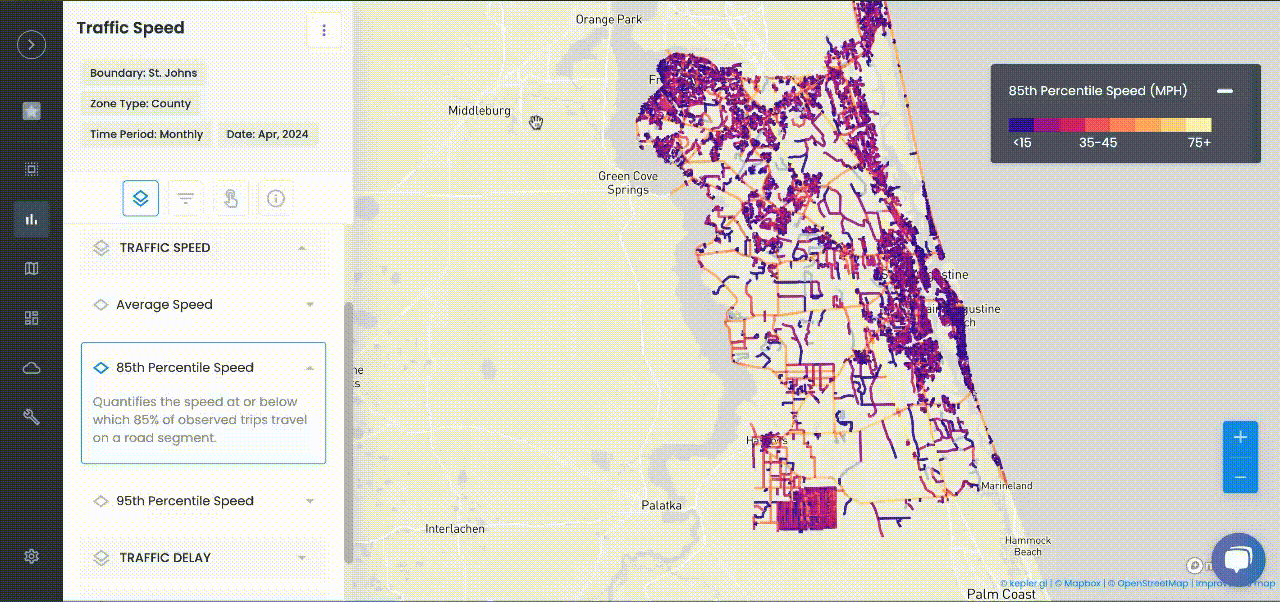
Congestion Management
Optimizing Urban Freight Deliveries: Data Strategies for Sustainable City Logistics
Cities can use traffic, demographic, and mobility data to design and manage equitable, effective congestion pricing programs
Urban freight deliveries are a double-edged sword for cities. On one hand, efficient last-mile logistics keep businesses and residents supplied; on the other, delivery vans and trucks contribute significantly to traffic congestion and emissions. E-commerce growth has led to a last-mile delivery boom – for example, Manhattan saw a 55% rise in delivery stops and 46% more delivery vehicles in recent years. Without intervention, the impact could be dire: delivery traffic in major cities might surge carbon emissions by up to 60% by 2030 and add 5 minutes to the average commute. Clearly, cities need data-driven strategies to optimize freight and reduce these externalities.
The Data Gap in Urban Freight
Historically, cities lacked reliable data on freight movement. Much delivery information is fragmented across private companies or not collected at all. “Without reliable data on how people and goods move, making informed choices about future transport planning is a major challenge,” notes a World Economic Forum report. In fact, cities often do not even know basic metrics like how many delivery trucks operate or where loading occurs most, hampering their ability to craft effective policies. This data gap means inefficient logistics go unchecked, contributing to congestion, pollution, and wasted curb space.
Urban SDK helps cities close this data gap through our mobility data platform, providing access to real-time traffic speed, volume, and travel time delay insights. With accurate, high-resolution data on freight flows, delivery volumes, timing, and vehicle movements, city planners can finally make decisions based on facts—not assumptions.
Data-Driven Delivery Optimization
With good data in hand, cities and companies can collaborate to streamline last-mile deliveries. Modern fleet telematics and sensors generate rich datasets on routes, stop durations, and traffic conditions. AI-driven platforms can ingest these datasets to optimize delivery routes and schedules in near-real time. For instance, Geotab’s Altitude platform uses data intelligence and AI for route optimization, giving a city-wide view of freight vehicle movements and adjusting routes on the fly to avoid jams. Such tools ensure “safe, reliable deliveries even in the midst of congested city streets” by analyzing traffic data and finding the most efficient paths. Delivery companies, too, leverage data to cut waste – UPS famously used route data to minimize left turns, saving time and fuel. In sum, by crunching data on traffic and orders, AI algorithms can reduce delivery vehicle miles traveled, idle time, and conflicts on busy roads.
Urban SDK supports these efforts with traffic congestion tools that allow cities to analyze and visualize freight-related congestion in real time, helping optimize routing and reduce delays.
Collaborative Data Sharing
Public-private data sharing is emerging as a key strategy for sustainable urban logistics. No single entity has a complete picture – cities hold traffic and infrastructure data, while shippers and carriers have operations data. Combining these can yield powerful insights. In South Africa, for example, the government of Cape Town is integrating freight data from private apps to inform its freight plan. By sharing data across sectors, cities can identify hotspots of delivery activity and coordinate solutions like new loading zones or off-peak delivery programs. A World Economic Forum meeting highlighted that collaboration in data collection helps create a comprehensive approach to urban freight and leads to better planning. Some cities aggregate freight data in open platforms accessible to stakeholders – Portland, Oregon built an open data library with freight metrics (air quality, truck volumes, etc.) to involve citizens and businesses in freight planning.
Urban SDK’s features support collaborative data efforts by enabling transportation officials to build live dashboards, share traffic datasets, and integrate third-party mobility data securely.
Smarter Curbside Management
Data is also transforming how we manage curb space for deliveries. Unregulated curb activity (trucks circling or double-parking in bike lanes) is a major cause of urban traffic snarls. By deploying IoT sensors or analyzing GPS traces, cities can monitor curb usage in real time – where and when are delivery vehicles stopping? With that intelligence, policies like dynamic loading zones or permits can be introduced. For instance, some cities now designate “smart” loading zones that delivery drivers reserve via an app, providing the city with a stream of data on loading duration and frequency. These programs recommend flexible pricing for loading zones to match supply with demand. New York City has even used data analytics to adjust curb regulations, such as creating overnight delivery zones to shift freight activity out of peak hours. In short, treating curb space as a dynamic resource – informed by data on how it’s used – can reduce illegal stops and keep traffic flowing.
Urban SDK’s traffic volume and travel time delay metrics help cities identify which curbs are overburdened during key delivery windows. Combined with our geospatial mapping tools, city officials can design smarter curbside programs that align with actual vehicle behavior.
Sustainable Outcomes Through Data
All these data-driven strategies aim at one result: more sustainable city logistics. Early results are promising. When cities apply data to freight planning, it “helps leaders make informed decisions” to address last-mile challenges. For example, when freight data revealed that 70% of Lawrence, KS sidewalks and curb ramps were in disrepair, the city secured funding to fix them as part of an ADA plan – improving efficiency and safety for delivery carts and pedestrians alike. On a larger scale, the World Economic Forum reports that comprehensive measures (like routing software, consolidated delivery hubs, and electric vans) could prevent a forecast 14% increase in congestion and 30 hours of lost time per driver by 2030. Companies are also innovating using data: pilots with electric delivery bikes and smart lockers have shown up to 15% fewer trips and 2% less congestion by reducing failed deliveries and consolidating stops. Data underpins these solutions by pinpointing where such interventions will have the greatest impact.
Urban SDK provides a foundation for these innovations with our citywide analytics platform, powering everything from road characteristics data to traffic calming initiatives that reduce risk in freight-heavy zones.
In Conclusion
Optimizing urban freight requires shifting from guesswork to data-driven planning. By collecting the right data and leveraging AI and analytics, cities can redesign last-mile logistics to be both efficient and low-emission. The payoff is substantial – cities will see fewer trucks clogging the streets and lower CO2 and noise pollution. Meanwhile, businesses benefit from faster, more reliable deliveries. As one report put it, “to solve these challenges, the best ally a city can have is data,” which empowers both city officials and freight operators to make smarter choices.
Urban SDK stands ready to support city leaders with actionable freight intelligence. Through real-time traffic data, mobility insights, and collaborative dashboards, we help make sustainable urban freight not just a vision—but a measurable reality.
FAQs
Q1. How can cities use data to reduce congestion caused by urban freight deliveries?
Ans: Cities leverage traffic, mobility, and delivery data to identify freight hotspots and congestion patterns. This enables them to design efficient routing, optimize delivery timing, and implement policies like congestion pricing or off-peak deliveries to ease traffic impact.
Q2. What types of data are essential for optimizing last-mile deliveries?
Ans: Key data includes GPS trip logs from delivery fleets, real-time traffic speeds and volumes, delivery stop durations, and collision data. Combining these with weather and demographic information produces actionable insights to streamline deliveries.
Q3. How does AI improve freight routing and reduce delivery times in cities?
Ans: AI-driven platforms analyze real-time and historical traffic data to optimize routes dynamically, avoiding traffic jams and minimizing travel distances. This results in faster, safer, and more reliable deliveries while reducing fuel consumption and emissions.
Q4. What is collaborative data sharing in urban freight logistics?
Ans: Public agencies and private logistics firms share anonymized delivery and traffic data to create a comprehensive view of freight flows. Such collaboration supports coordinated policies like dynamic loading zones, congestion mitigation, and equitable infrastructure investments.
Q5. How can cities better manage curb space to improve freight efficiency?
Ans: Cities deploy IoT sensors and GPS tracking to monitor curb usage in real time, enabling dynamic pricing for loading zones and scheduling deliveries during off-peak hours. This reduces illegal parking and double-parking, freeing up traffic lanes and improving flow.
Q6. What are the sustainability benefits of optimized urban freight?
Ans: Data-driven delivery strategies reduce vehicle miles traveled, lower emissions, and decrease traffic delays. Initiatives like consolidated deliveries, electric fleets, and smart loading zones contribute to cleaner, greener urban logistics.
Q7. How are cities using analytics to prioritize investments in freight infrastructure?
Ans: By mapping freight traffic and delivery demand alongside equity and safety data, cities identify priority areas for infrastructure upgrades, such as curb improvements, dedicated loading zones, and transit-accessible freight hubs.
Q8. What role does Urban SDK play in optimizing urban freight logistics?Ans: Urban SDK provides a mobility data platform that integrates traffic, freight, and proximity data into live dashboards, enabling cities to monitor freight flows, assess congestion impact, and plan targeted improvements for sustainable logistics.

TRAFFIC ENFORCEMENT FEATURES
80% of citizen complaints
are a perception problem
Urban SDK provides precise hourly speed data to evaluate complaints and deploy resources efficiently for the greatest impact to public safety.
Urban SDK provides precise hourly speed data to evaluate complaints and deploy resources efficiently for the greatest impact to public safety.
Target Speeding
Identify hot spots, validate monthly speeding trends and monitor vulnerable areas like school zones.
Improve Safety
Crash and citations location information to compare speed trends month over month
Fast Response
Respond to citizen complaints sooner with address search and exportable reporting
Deploy Assets
Generate maps for traffic enforcement by time of day, location or division to deploy officers to known problem areas.
RESOURCES
Customer Success
See how public sector leaders succeed with Urban SDK.
WEBINAR
Identify speeding and proactively enforce issues
See just how quick and easy it is to identify speeding, address complaints, and deploy officers.







